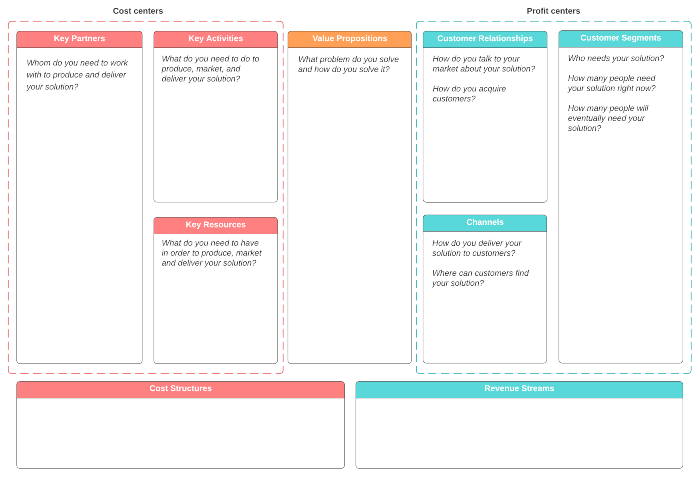The Business Model Canvas’s Value Proposition for your Business Plan

Entrepreneurship always involves an obstacle course to traverse to make your venture a success. The path is not always an easy one, and questions like “where do I start?” or “Will I be successful?” spring doubts into our minds as we work on launching our idea. Developing a business plan will eliminate those questions of self-doubt and guide you in having a firm idea of your circumstances when starting. When designing your business plan, the Business Model Canvas has a clear value proposition that can guide you in this crucial task.
First off, a business plan is more than just a necessity. It lets you find out how your new business will work: its objective, target market, competitors, the added value it brings, and more. We’ll also show the initial investment we’ll make, the financing we need, how to position ourselves in our target market, our projected earnings, as well as short-and-medium-term spending. The Business Model Canvas methodology lets you define your business strategy in a straightforward, dynamic, effective way.
The Business Model Canvas that revolutionized business plans
Business plans have also evolved and moved far away from the documents that only economists and labor experts could decipher. As part of his doctoral thesis at the University of Lausanne, Alexander Osterwalder created the Business Model Canvas that he detailed in the 2010 book, Business Model Generation, he co-authored with University of Lausanne Professor Yves Pigneur. Osterwalder proposed a business model fostered on innovation and new ways of creating, submitting deliverables, and acquiring value for customers.
Using a comprehensive model, the Business Model Canvas analyzes the business as a whole and serves the basis for creating and developing the business model you’ll implement. Experts consider it to be an accessible, strategic innovation tool that we can apply to our entity, whether it be an SMB or a large-scale enterprise. The Business Model Canvas is a straightforward tool to help you define your organization’s business model and strategy.
The Business Model Canvas’s value proposition in nine building blocks
When defining the Canvas methodology, Osterwalder claims that the best way to describe a business model is to break it down into nine fundamental elements that reflect the logic of how a company seeks to make money. The elements encompass the main parts of a business: customers, offering, infrastructure, and financial viability.

Source: Lucidchart
Customer Segments
There are no customers if you don’t know who they are. As the basis of your enterprise, you have to know everything about them: that means understanding the geographic, social, and demographic information about them from their age range, gender, location, education level, and more. You have to paint the most precise picture of the type of person your product or service is targeting to define detailed customer profiles. It should include the following details:
-
Overall market
-
Market niche
-
Segmented
-
Diversified
-
Across all channels
Value Propositions
What do you offer consumers that makes you stand out from the rest? Your answer should entail a unique, innovative value proposition that satisfies a need or solves a problem that your competitors do not. This section should include the following:
-
Newness
-
Personalization
-
Branding
-
Cost reduction
Channels
How are you going to make sure your customers acquire your product or contract your service? In your Business Model Canvas, figure out how you’ll communicate with, reach, and deliver your value proposition to your customers. This combination will determine how successful your project is since Osterwalder claims that when you bring them together, you give customers the chance to have an extraordinary experience and lead to an increase in earnings.
-
Awareness
-
Consideration
-
Sale
-
Delivery
-
Post-Sale
Customer Relationships
Decide how to attract prospects and turn them into customers, retain them, and make them grow. Study the working methodologies such as Design Thinking you’ll integrate into this step because, after all, every customer is a world.
-
Personal assistance
-
Dedicated assistance
-
Self-service
-
Automated service
-
Communities
Revenue Streams
Have you thought about how you’ll make money? How much are your customers willing to spend on your products? The Canvas Business Model will help you make that decision. The payment method is crucial for both you and your customers, and figure out what payment methods you’ll accept (whether they be credit or debit cards, PayPal, bank transfers, AfterPay, and so on).
-
Stock equity
-
Fixed pricing
-
Variable profits
-
Taxes
Key Resources
Write down everything you need to get your project off the ground, whether it’s investments, human capital, intellectual property, etc. This analysis determines your project’s viability. Here is where you’ll find out if you need a specialized team, the areas where you can (or must) externalize, and other critical parts of your business needs.
-
Physical
-
Intellectual
-
Human
-
Financial
Key Activities
Identify the critical activity that will allow your company to start making money. Identifying your crucial activity helps us prove who we are and what we want to be on the market: production, marketing, consulting firm. So what are you?
-
Production
-
Problem-solver
-
Platforms
Key Partnerships
Write down your key partners to ensure your business model works appropriately and can sustain itself. In essence, you need to list the essential partnerships to guarantee you can operate your business model without a hitch. Collaboration and co-creation are imperative in the way you work.
-
Optimization
-
Business
-
Risk minimization
-
Co-creation
Cost Structure
Note what the most expensive resources are, along with the activities that involve the most spending, fixed and variable costs, taxes, and everything else that will impact your business’s bank account. Once you have them all laid out on the table, you’ll be able to optimize them and craft an efficient business model.
-
Low costs
-
Fixed costs
-
Variable costs
-
Value
The nine building blocks that form the Business Model Canvas bring value to your business are on the template, making it more attractive through having a total view of your company in one place. Once you have them all defined and completed, you’ll have successfully created the core of your business model that will become the basis for your work to achieve success in the business world.
The Business Model Canvas’s benefits
Since its inception, this tool has become one of the most-preferred among entrepreneurs starting a venture. Its attractiveness stems from its ability to make people straightforwardly create strategic business plans. Plus, the Business Model Canvas’s value proposition is that it’s an indisputably practical methodology that lets you display your ideas quickly and visually.
Furthermore, this model has a tremendous ability to adapt as projects take shape and evolve. The reason for this is that the single view gives you a conceptualized overall idea of each component that plays a part in the business. Plus, the model displays that idea in an intuitive, interactive way for those who manage it at a strategic level.
It’s certainly a simple tool that plays a role in your enterprise’s vital, day-to-day Business Intelligence by ensuring that the company’s ideas function as a whole through displaying the bonds between each building-block. As Osterwalder and Pigneur note, the Business Model Canvas “...is a hands-on tool that fosters understanding, discussion, creativity, and analysis.” Since, in their words, “[a] business model describes the rationale of how an organization creates, delivers, and captures value,” the Business Model Canvas proves to be a fundamental value proposition in this step.
Subscribe to our newsletter and stay up to date with the latest digital trends.
Subscribe to our newsletter and stay up to date with the latest digital trends.
No thanks. My inbox is fine as it is.